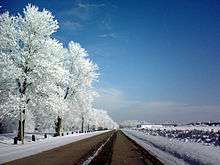Frost (temperature)
freezing[1] occurs when the temperature of air falls below the freezing point of water (0 °C, 32 °F, 273.15 K). This is usually measured at the height of 1.2 m above the ground surface.
There is a rather subjective scale to show several degrees of frost severity:
- slight frost: 0 to −3.5 °C (32.0 to 25.7 °F)
- moderate frost: −3.6 to −6.5 °C (25.6 to 20.3 °F)
- severe frost: −6.6 to −11.5 °C (20.2 to 11.3 °F)
- very severe frost: below −11.5 °C (11.3 °F)
A temperature at or below freezing is not necessary to get ground frost or hoar frost; they can form even if air temperature is above freezing point if the sky is clear. This is because the ground loses heat due to radiation. It radiates its heat to the sky/space. When you "feel" a very cold surface, it is because you are radiating your heat to that cold surface, the cold surface becomes warmer, and you become colder. The amount of heat that radiates is proportional to the difference in temperature between the two objects. At night, the atmosphere is not being warmed by the sun and the sky/space can approach absolute zero (-469 degrees F, -273 degrees Celsius). On a clear night the ground can become colder than the air because it radiates its heat to the sky, and frost can form.
Frost and hoar frost

In the English language, these terms are sometimes used in a confusing way. For example, frost is used sometimes to indicate ice which forms on the ground during cold nights, but other times to indicate air temperature below freezing point. Hoar frost should be used for any frosted surface but it is sometimes reserved to indicate big ice crystals forming on very cold surfaces. The WMO uses hoar frost in every case.[1]
See also
- Frost
- Rime (soft/hard)
References
- International Meteorological Vocabulary. Geneva: Secretariat of the World Meteorological Organization. 1992.
External links
| Wikimedia Commons has media related to Frost. |
| Look up frost (temperature) in Wiktionary, the free dictionary. |